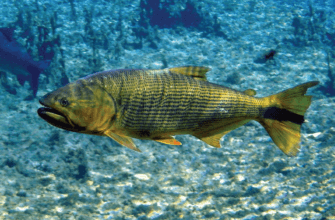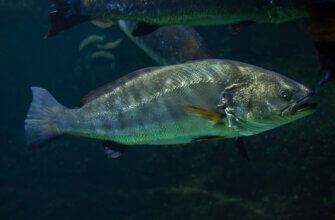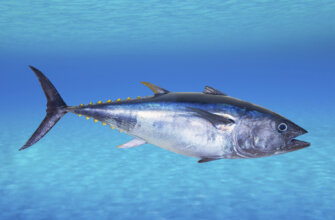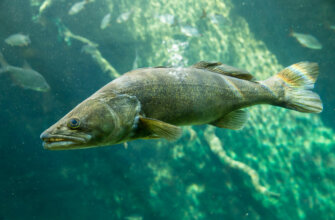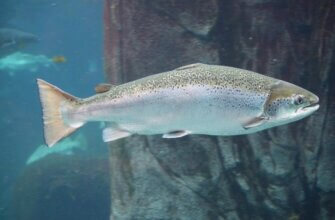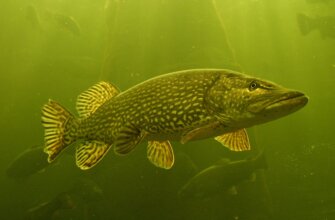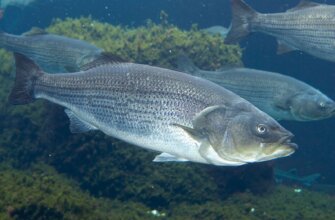Halibut is a type of flatfish that belongs to the family of the right-eye flounders. It is one of the largest and most popular flatfish species, known for its firm, white, and mild-tasting flesh.
Halibut is a popular fish for consumption due to its mild, sweet taste and versatile cooking options. It can be baked, broiled, grilled, fried, or even eaten raw as sushi. The flesh is high in protein, low in fat, and rich in vitamins and minerals such as vitamin B12, selenium, and phosphorus.
Due to its popularity, halibut is heavily regulated by fisheries management organizations in order to prevent overfishing and maintain sustainable populations. As a result, it is often more expensive than other types of fish.
Species
Halibut can grow up to 8 feet in length and weigh as much as 500 pounds, although most commercial halibut are typically around 20-40 pounds.
There are several species of halibut, but the two most commonly consumed are the Pacific halibut (Hippoglossus stenolepis) and the Atlantic halibut (Hippoglossus hippoglossus).
Pacific halibut is found in the North Pacific Ocean, from California to Alaska, and is generally larger than the Atlantic halibut, with an average weight of 20-40 pounds. It has a slightly sweeter taste and a more delicate texture than the Atlantic halibut. In the Pacific Ocean, the largest halibut are typically caught in Alaska, where they are known as “barn doors” due to their massive size. These fish can weigh over 300 pounds and are highly sought after by anglers and commercial fishermen alike.
Atlantic halibut, on the other hand, is found in the North Atlantic Ocean, from Norway to the Mediterranean. It is smaller than the Pacific halibut, with an average weight of 10-30 pounds. It has a firmer texture and a slightly stronger, more distinct flavor than the Pacific halibut. In the Atlantic Ocean, the largest halibut are typically found in the waters off the coast of Norway, where they can grow to be up to 6 feet in length and weigh over 200 pounds.

Both species of halibut are highly valued for their meat, and they are often used interchangeably in recipes. However, due to differences in their texture and flavor, some chefs and consumers prefer one over the other for certain preparations.
Appearance
Halibut is a type of flatfish, which means its body is flattened and its eyes are on the same side of its head. The top side of the halibut is typically a mottled brown or dark green color, while the underside is white. The body is diamond-shaped, with a broad head and a tapering tail.
One of the distinctive features of the halibut is its large size. It is one of the largest species of flatfish, and can grow up to 8 feet in length and weigh as much as 500 pounds.
Another distinctive feature of the halibut is its mouth, which is very large and extends beyond the eyes. This allows the fish to easily catch prey that is swimming above it, as it lies camouflaged on the ocean floor.
Overall, halibut is a relatively plain-looking fish, but its large size and distinctive body shape make it easily recognizable.
Size and weight
The size and weight of halibut can vary depending on a number of factors, including the location where they are caught, the age of the fish, and the availability of food in their habitat. However, regardless of their size, halibut are highly prized for their delicious meat and are a popular target for commercial and recreational fishermen.
Diet
Halibut are carnivorous and primarily feed on other fish and invertebrates. Their diet varies depending on their size and location, but some of the common prey items for halibut include:
- Pacific herring
- Sand lance
- Cod
- Pollock
- Crab
- Shrimp
- Squid
- Octopus
As young fish, halibut typically feed on small crustaceans and plankton, but as they grow larger, they begin to focus more on larger prey items such as fish and other marine animals.
Halibut are opportunistic feeders, which means that they will eat whatever prey is available in their habitat. They are also known to be active hunters, using their camouflage to blend in with their surroundings and ambush prey that swims above them.
Overall, halibut are adaptable and opportunistic feeders, consuming a wide range of prey items depending on what is available in their environment.
Behavior
Halibut are bottom-dwelling fish that spend most of their time lying on the ocean floor, camouflaged against the sand or gravel. They are solitary creatures, and are typically found alone rather than in schools or groups.
Halibut are also known for their migration patterns, which can vary depending on their age and the time of year. Young halibut will often move to shallower waters to feed during the summer months, while larger adult halibut may migrate to deeper waters during the winter.
One interesting behavior of halibut is their ability to change color and pattern to match their surroundings. This allows them to blend in with the ocean floor and avoid detection by predators or prey.
Halibut are also active hunters, using their ambush-style hunting techniques to catch prey that swims above them. They have a large mouth and sharp teeth, which allow them to quickly and efficiently capture their prey.
Overall, halibut are relatively sedentary fish that spend most of their time lying on the ocean floor. However, they are also skilled hunters and are able to quickly and efficiently catch prey when the opportunity arises.
Spawning
Halibut reach sexual maturity between the ages of 8 and 12, depending on their size and location. They are typically long-lived fish, with some individuals living up to 50 years or more.
Halibut spawn in the winter months, typically from December to February in the North Pacific and from January to March in the North Atlantic. During this time, they will migrate to shallower waters and form spawning aggregations.
Male halibut will establish and defend territories, attracting females to lay their eggs in the area. Females can lay up to several million eggs each season, which are released into the water column and fertilized by the males.
The eggs will hatch after a few weeks, and the larvae will drift with the ocean currents for several months before settling on the ocean floor. As they grow, they will move to deeper waters and eventually reach sexual maturity, starting the cycle anew.
Halibut are known for their slow growth and low reproductive rate, which makes them particularly vulnerable to overfishing. As a result, there are strict regulations in place to protect halibut populations, including limits on catch size, season closures, and gear restrictions.
Fishing

Halibut fishing is a popular commercial and recreational activity in many parts of the world, particularly in Alaska and Norway where the largest halibut are typically found. Halibut are highly valued for their firm, white meat, and are prized as a food fish.
There are a number of methods used to catch halibut, including:
- Longlining: Longlining is a method where a long line with multiple hooks is deployed from a fishing vessel. The line is left in the water for a period of time before being hauled back in, with the catch being removed from the hooks as they are brought in.
- Trawling: Trawling is a method where a large net is dragged behind a fishing vessel, capturing fish as they swim in front of the net.
- Jigging: Jigging is a method where a weighted lure is dropped to the ocean floor and then jerked up and down to attract the fish.
- Spearfishing: Spearfishing is a method where the fisherman dives into the water and uses a spear to catch the fish.
Halibut fishing is tightly regulated in many areas to protect the health of the fish populations. Regulations may include catch limits, size limits, and restrictions on fishing gear and fishing season. In some areas, catch-and-release fishing is also encouraged to promote sustainable fishing practices.
Baits
There are several types of baits that are commonly used for halibut fishing, including:
- Herring: Herring is a popular bait for halibut fishing and can be used whole or cut into chunks. Some popular herring baits for halibut fishing include:
- Luhr-Jensen Herring Rig: This rig comes pre-rigged with a treble hook and a leader, making it easy to use right out of the package.
- Pautzke Fire Brine Herring: This bait is soaked in a special brine solution that makes it more durable and attractive to halibut.
- Yakima Bait Big Al’s Fish Flash: This flasher is designed to attract halibut and other game fish, and can be used in combination with herring or other baits.
- Squid: Squid is another popular bait for halibut fishing and can be used whole or cut into strips. Some popular squid baits for halibut fishing include:
- Berkley Gulp! Squid: This soft plastic bait is infused with a powerful scent that can attract halibut from a distance.
- Rhys Davis Super Hoochie: This hoochie features a squid-like shape and movement that can attract halibut and other game fish.
- P-Line Laser Minnow: This lure is designed to mimic the movement of a wounded squid and can be an effective bait for halibut.
- Octopus: Octopus is another effective bait for halibut fishing and is often used in combination with other baits such as herring or squid. Some popular octopus baits for halibut fishing include:
- Mustad Demon Perfect Circle Hook: This hook is designed to hold bait securely and is a popular choice for octopus baits.
- Uncle Josh Meat Rig: This rig features a strip of octopus meat and can be an effective bait for halibut and other bottom fish.
- Blue Water Candy Sea Witch: This lure features a skirt that mimics the movement of an octopus and can be an effective bait for halibut.
- Sand Lance: Sand lance, also known as sand eels, are a common prey item for halibut and can be an effective bait when fishing in areas where they are present. Some popular sand lance baits for halibut fishing include:
- Savage Gear Sandeel: This soft plastic bait is designed to mimic the slender shape and movement of sand eels and can be an effective bait for halibut.
- Hogy Sand Eel: This soft plastic bait is infused with a powerful scent and can be rigged on a jighead or used as a trailer on a bucktail jig.
- Tsunami Holographic Sand Eel: This lure features a holographic finish that can attract halibut and other game fish, and can be used with or without bait.
When using bait for halibut fishing, it’s important to use a large hook and rig it properly to ensure that the bait stays on the hook and can withstand the powerful bite of a halibut. Many anglers use a “bait rig” that features multiple hooks and beads, with bait attached to each hook. This can increase the chances of hooking a halibut and is especially effective when fishing from a drifting boat.
Lures
When it comes to halibut fishing, the choice of lure can be critical to success. Here are some popular types of lures used for halibut fishing:
- Jigs: One popular jig for halibut fishing is the “Butterfly Jig” made by Shimano. This jig is designed to flutter and move erratically in the water, mimicking the movement of injured prey. It comes in a variety of sizes and colors, with weights ranging from 80 to 250 grams. Another popular option is the “Point Wilson Dart” made by Gibbs Delta. This jig features a diamond-shaped body that creates a unique fluttering action in the water and is available in a variety of sizes and colors.
- Swimbaits: One popular swimbait for halibut fishing is the “Big Hammer” made by Fisherman’s Warehouse. This soft plastic bait is designed to mimic the movement of live baitfish and comes in a variety of colors and sizes, ranging from 5 to 12 inches. Another popular option is the “Savage Gear Sandeel” made by Savage Gear. This swimbait is designed to mimic the slender shape and movement of sand eels, a common prey item for halibut.
- Spoons: One popular spoon for halibut fishing is the “Gibbs Croc” made by Gibbs Delta. This spoon features a unique wobbling action that is designed to mimic the movement of injured baitfish, and comes in a variety of sizes and colors. Another popular option is the “Kastmaster” made by Acme Tackle. This spoon is designed to cast well and sink quickly, and is available in a variety of weights and colors.
- Hoochies: One popular hoochie for halibut fishing is the “Big Eye Custom Hoochie” made by Rhys Davis. This soft plastic bait is designed to mimic the movement of squid and octopus, and comes in a variety of colors and sizes. Another popular option is the “Jellyfish” made by Hali Tackle. This hoochie features a unique jellyfish-like shape and movement, and is available in a variety of colors.
- Bait: When it comes to using bait for halibut fishing, herring and squid are two popular options. Many anglers use whole herring or squid rigged on a large hook, or cut bait on a spreader bar with multiple hooks. Another option is to use a “bait rig,” which typically features multiple hooks and beads, with herring or squid attached to each hook. Some popular bait rig options include the “Sea Striker Bait Rig” and the “Gamakatsu Circle Hook Rig.”
When selecting a lure for halibut fishing, it is important to consider the depth and location of the fishing spot, as well as the size and behavior of the halibut in the area. Experimenting with different lures and techniques can also help you find what works best for your fishing style and the specific conditions on any given day.
Fishing
Halibut fishing rods are specialized fishing rods designed for catching halibut, a type of flatfish found in cold, deep waters. These rods are typically longer and heavier than standard fishing rods, as they need to be able to handle the weight and power of large halibut.
Here are some key details about halibut fishing rods:
- Length: Halibut fishing rods are typically between 6 and 7.5 feet long, although some models can be longer. The longer length allows for greater casting distance and better leverage when fighting a fish.
- Power: Halibut fishing rods are rated by their power, which is the amount of force needed to bend the rod. Halibut rods are typically rated as heavy or extra-heavy power, which means they can handle the weight of large fish.
- Action: The action of a halibut rod refers to how much the rod bends when pressure is applied. Most halibut rods have a fast or extra-fast action, which means they are stiff and don’t bend much. This allows for greater sensitivity and control when fishing in deep water.
- Material: Halibut fishing rods are typically made from graphite or composite materials, which provide strength and sensitivity while keeping the weight of the rod down.
- Guides: The guides on a halibut fishing rod are usually oversized to accommodate the thicker line used when fishing for halibut. These guides are often made from heavy-duty materials such as stainless steel to withstand the weight and abrasion of the fishing line.
Overall, a good halibut fishing rod should be strong, durable, and able to handle the weight and power of large fish. When choosing a halibut rod, consider factors such as length, power, action, and material to ensure you get a rod that is suitable for the type of fishing you plan to do.
Here are some examples of fishing rods that are suitable for catching halibut, along with their models and specifications:
- Penn Carnage II Halibut Casting Rod – Model: CARJGII3080C66; Length: 6’6″; Power: Extra-Heavy; Action: Fast; Line Weight: 80-200 lb.; Lure Weight: N/A; Material: Graphite composite; Guides: 7+1 stainless steel.
- Shimano Tallus Blue Water Halibut Casting Rod – Model: TLC80XHBBL; Length: 8′; Power: Extra-Heavy; Action: Fast; Line Weight: 80-200 lb.; Lure Weight: 10-16 oz.; Material: TC4 blank construction; Guides: Fuji Hardloy.
- St. Croix Avid X Halibut Casting Rod – Model: AXCH86XHF; Length: 8’6″; Power: Extra-Heavy; Action: Fast; Line Weight: 80-200 lb.; Lure Weight: N/A; Material: SCIII graphite; Guides: Kigan Master Hand 3D guides.
- Okuma Cedros CJ-80S Halibut Casting Rod – Model: CJ-80S; Length: 8′; Power: Extra-Heavy; Action: Fast; Line Weight: 80-200 lb.; Lure Weight: 10-16 oz.; Material: 30-ton carbon blank construction; Guides: ALPS heavy-duty guides.
- Daiwa Proteus SS Halibut Casting Rod – Model: PRSS86XHF; Length: 8’6″; Power: Extra-Heavy; Action: Fast; Line Weight: 80-200 lb.; Lure Weight: N/A; Material: HVF carbon blank construction; Guides: Fuji Alconite.
These are just a few examples of the many halibut fishing rods available on the market. When selecting a rod, consider your personal preferences and fishing style, as well as the specific conditions you’ll be fishing in.
Dishes

Halibut is a versatile and delicious fish that can be prepared in a variety of ways. Here are some popular dishes featuring halibut:
- Grilled Halibut: Grilled halibut is a simple and healthy way to enjoy this fish. Brush the halibut fillets with olive oil and season with salt and pepper. Grill over medium-high heat for about 4-5 minutes per side, until the fish is opaque and flakes easily with a fork.
- Halibut Tacos: Halibut tacos are a fresh and flavorful way to enjoy this fish. Season halibut fillets with chili powder, cumin, and lime juice. Grill or pan-sear the fish until cooked through, then serve in warm tortillas with avocado, salsa, and cilantro.
- Halibut Chowder: Halibut chowder is a creamy and comforting soup that’s perfect for cooler weather. Simmer halibut fillets in a broth made from chicken or fish stock, cream, and vegetables such as potatoes, onions, and carrots. Season with herbs and spices to taste.
- Halibut Ceviche: Halibut ceviche is a refreshing and tangy dish that’s perfect for summer. Cut halibut fillets into small cubes and marinate in lime juice, orange juice, and diced tomatoes and onions. Serve with tortilla chips or on a bed of lettuce.
- Baked Halibut: Baked halibut is a simple and flavorful way to prepare this fish. Place halibut fillets in a baking dish and top with a mixture of breadcrumbs, Parmesan cheese, and herbs such as parsley or dill. Bake at 375 degrees F for about 15-20 minutes, until the fish is cooked through and the topping is golden brown.
These are just a few examples of the many ways to enjoy halibut. Whether grilled, baked, or served in a soup or salad, halibut is a versatile and delicious fish that can be incorporated into a variety of dishes.

